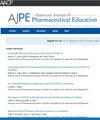A Blended Learning Approach to Teaching Medication Use and Perspectives on Spirituality in Pharmacy Practice
IF 3.8
4区 教育学
Q1 EDUCATION, SCIENTIFIC DISCIPLINES
引用次数: 0
Abstract
Objective
This study aimed to assess students’ proficiency and perspectives regarding the role of spirituality in pharmacy practice using a blended learning approach.
Methods
Students viewed online preclass videos on general spirituality and 5 major religions in the United States. Next, students attended an interactive lecture followed by a simulated counseling session. Lastly, students completed an anonymous, 38-question, electronic perspective survey. The items were grouped into scales, and the results were compared using paired-sample t tests. Effect sizes were measured by Cohen’s d. Additionally, students could opt to complete a reflection assignment on this activity as part of a concurrent course. A content analysis qualitative approach was utilized to assess these reflections.
Results
All students (N = 125) completed the counseling session, and 113 (90.4%) completed the survey. The mean score on the counseling session rubric was 94.8%, demonstrating students’ skills in recognizing spiritual concerns in simulated patient interactions. All perspective scale scores indicated a statistically significant change from pre to post, with the greatest change demonstrated in empathic perspective-taking (medium effect), followed by anxiety and lack of multicultural self-efficacy, religious/spiritual openness, and desire to learn (small effects). Students agreed that the instruction helped prepare them as a pharmacist (mean = 5.41) and that hearing from people with authentic experiences was valuable (mean = 5.40). Major learning themes included individualizing care, respect for beliefs, learning about diverse backgrounds, and prohibited medications.
Conclusion
Students performed well in counseling patients regarding medication-related spiritual needs using a blended learning approach. In addition, the students perceived an increase in empathy while addressing spiritual considerations in patient care.
在药学实践中教授药物使用和精神视角的混合学习方法。
目的采用混合式学习方法,评估学生的表现以及对灵性在药学实践中的作用的看法:方法: 学生在课前在线观看了关于一般灵性和美国五大宗教的视频。接下来,学生们参加了互动讲座,然后进行了模拟咨询。最后,学生们完成了一份匿名的、包含 38 个问题的电子观点调查。调查项目按量表结果分组,并使用配对样本 t 检验进行比较。此外,学生还可以选择在同时进行的课程中完成一项有关该活动的反思作业。我们采用内容分析的定性方法来评估这些反思:所有学生(n=125)都完成了咨询课程,113 名学生(90.4%)完成了调查。咨询环节评分标准的平均得分率为 94.8%,显示了学生利用模拟病人识别精神问题的技能。所有视角量表的得分都表明,从课前到课后,学生的变化在统计学上具有显著性,其中变化最大的是移情视角(中等影响),其次是焦虑和缺乏多元文化自我效能感、宗教/精神开放性和学习欲望(小影响)。学生们一致认为,教学有助于他们为成为药剂师做好准备(平均值=5.41),而聆听具有真实经历的人的意见也很有价值(平均值=5.40)。主要学习主题包括个性化护理、尊重信仰、了解不同背景和禁用药物:学生们在利用混合式学习方法为患者提供与用药相关的精神需求咨询方面表现良好。此外,学生们在解决病人护理中的精神问题时,也增强了同理心。
本文章由计算机程序翻译,如有差异,请以英文原文为准。
求助全文
约1分钟内获得全文
求助全文
来源期刊
CiteScore
4.30
自引率
15.20%
发文量
114
期刊介绍:
The Journal accepts unsolicited manuscripts that have not been published and are not under consideration for publication elsewhere. The Journal only considers material related to pharmaceutical education for publication. Authors must prepare manuscripts to conform to the Journal style (Author Instructions). All manuscripts are subject to peer review and approval by the editor prior to acceptance for publication. Reviewers are assigned by the editor with the advice of the editorial board as needed. Manuscripts are submitted and processed online (Submit a Manuscript) using Editorial Manager, an online manuscript tracking system that facilitates communication between the editorial office, editor, associate editors, reviewers, and authors.
After a manuscript is accepted, it is scheduled for publication in an upcoming issue of the Journal. All manuscripts are formatted and copyedited, and returned to the author for review and approval of the changes. Approximately 2 weeks prior to publication, the author receives an electronic proof of the article for final review and approval. Authors are not assessed page charges for publication.

 求助内容:
求助内容: 应助结果提醒方式:
应助结果提醒方式:


